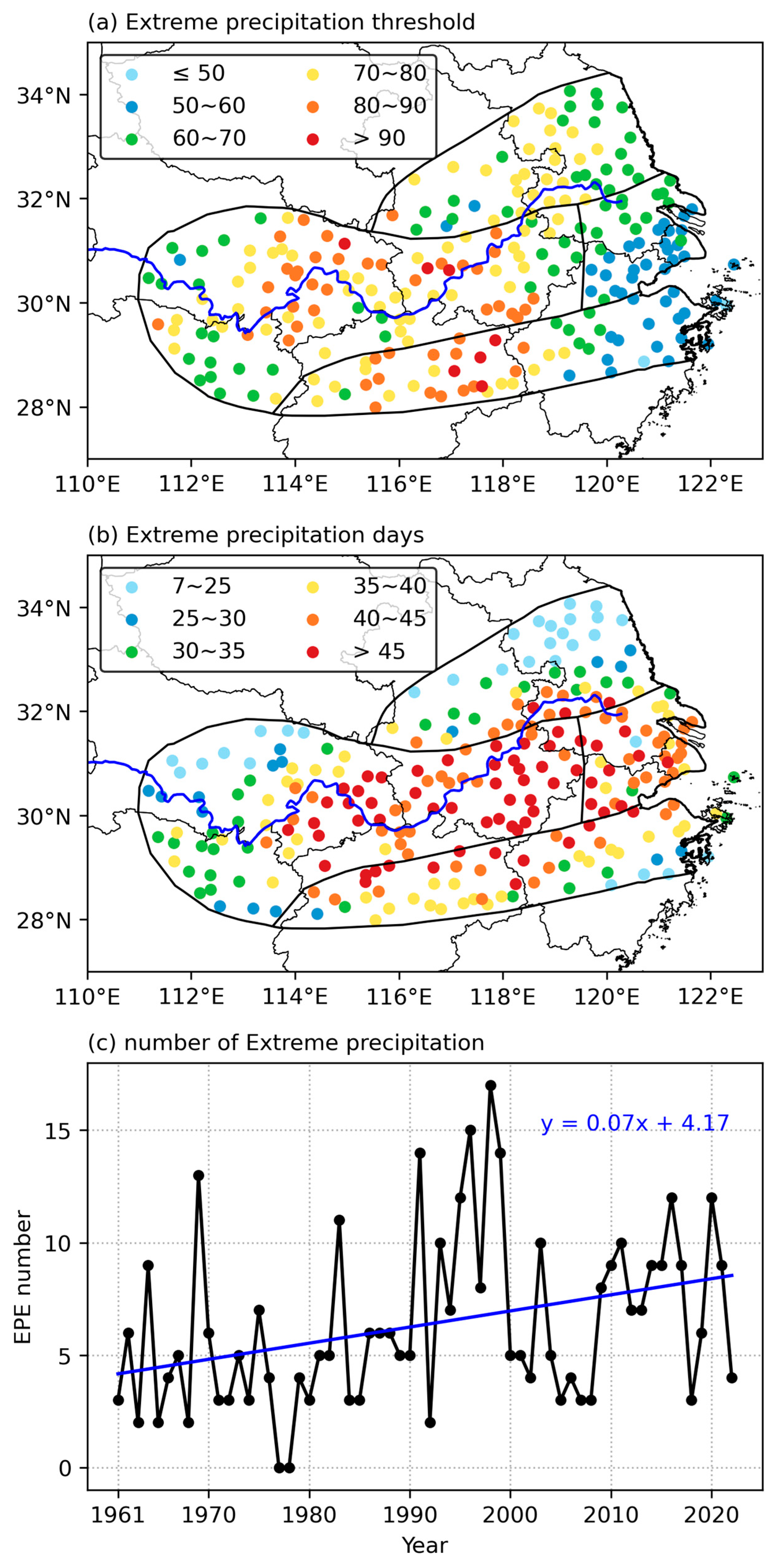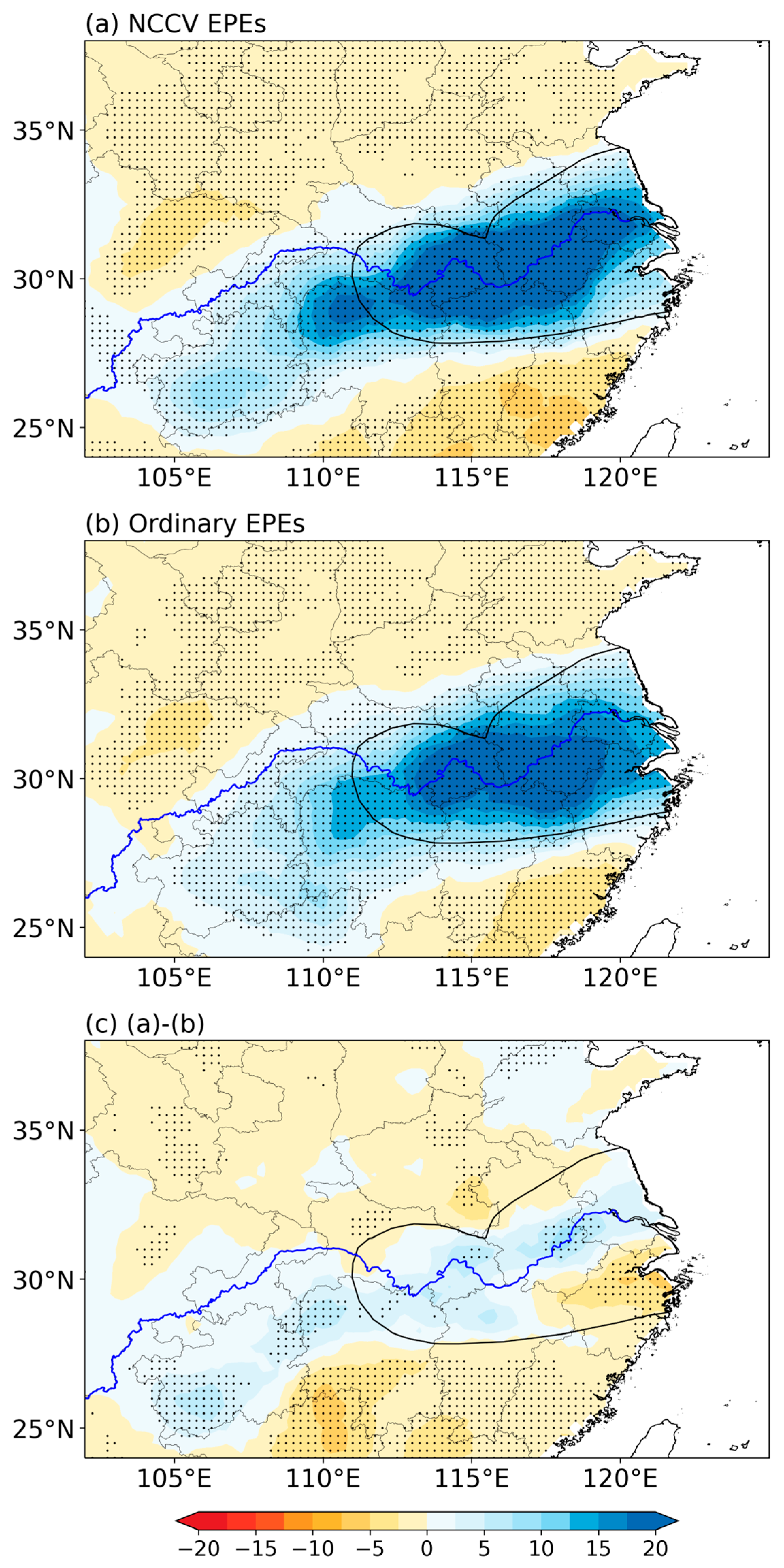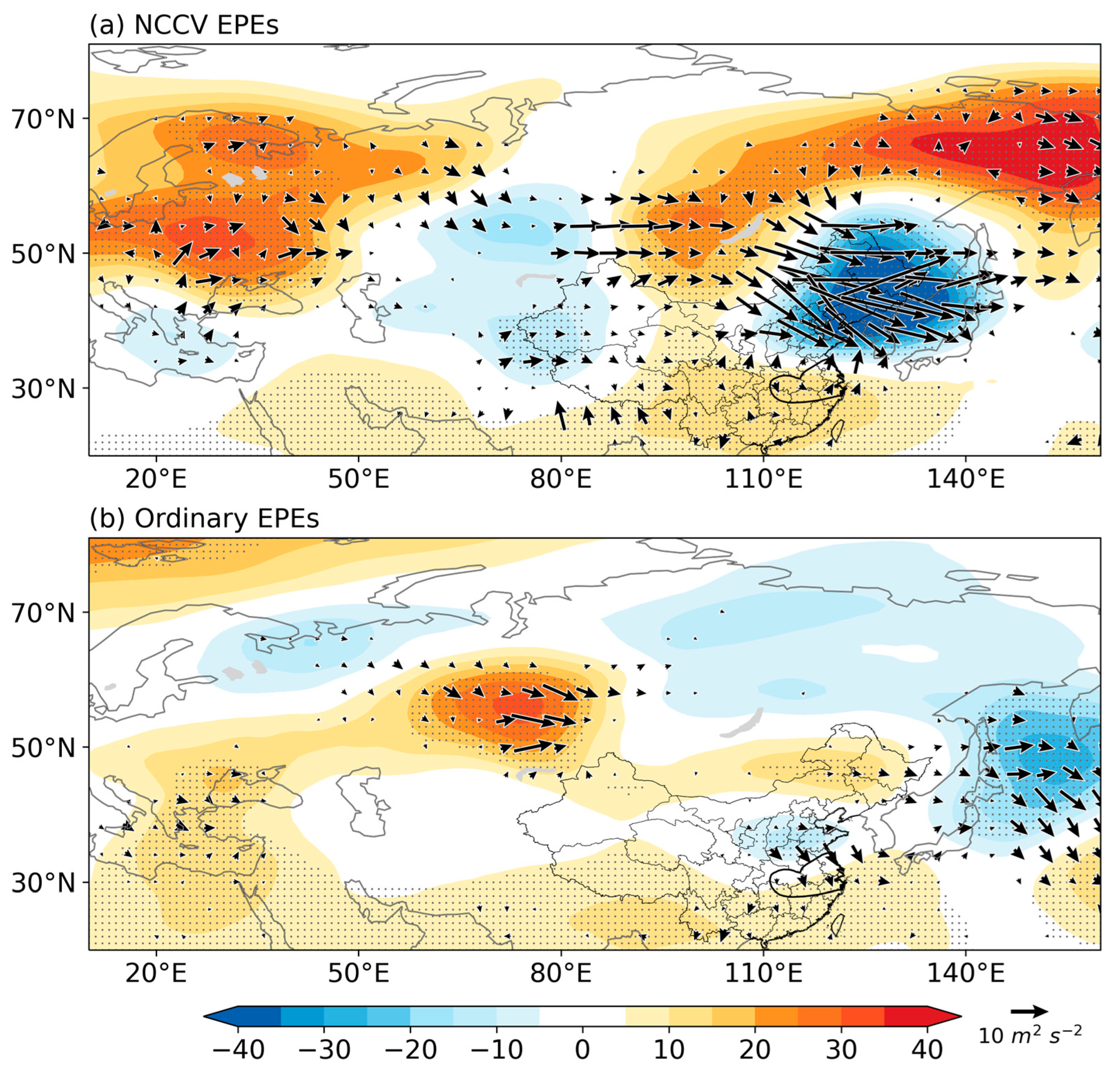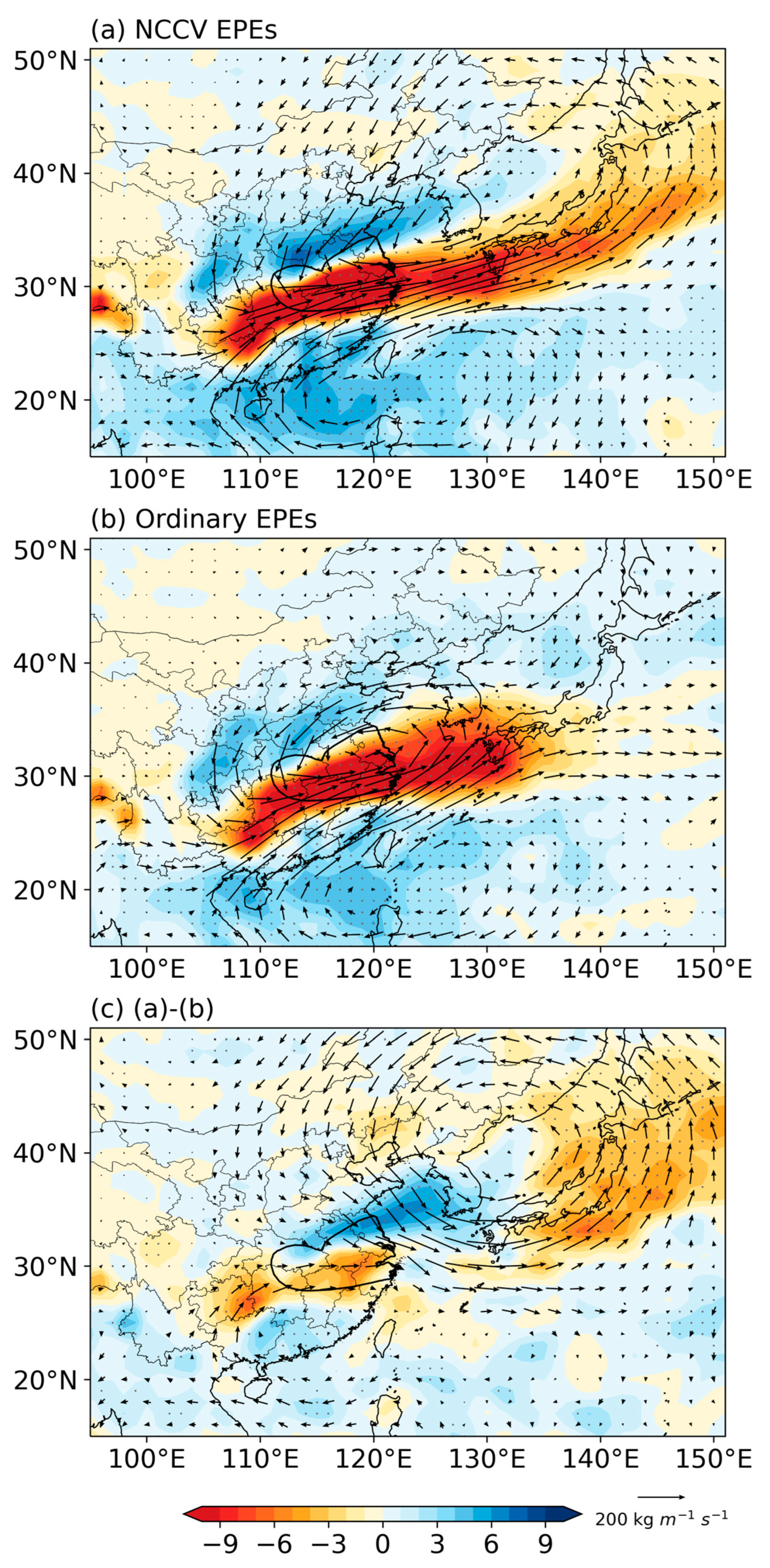Northeast China Cold Vortex Amplifies Extreme Precipitation Events in the Middle and Lower Reaches Yangtze River Basin
Abstract
:1. Introduction
2. Data and Methods
2.1. Study Area
2.2. Data
2.3. EPE Identification
2.4. NCCV Identification
2.5. Rossby Wave Activity Flux
3. Results
3.1. Distribution of Extreme Precipitation
3.2. Ciruclation Configuration
3.3. Differences in Factors Governing Precipitation
4. Conclusions and Discussion
Author Contributions
Funding
Institutional Review Board Statement
Informed Consent Statement
Data Availability Statement
Acknowledgments
Conflicts of Interest
References
- Gu, X.; Ye, L.; Xin, Q.; Zhang, C.; Zeng, F.; Nerantzaki, S.; Papalexiou, S. Extreme precipitation in China: A review on statistical methods and applications. Adv. Water Resour. 2022, 163, 104144. [Google Scholar] [CrossRef]
- Jones, C.; Waliser, D.; Lau, K.M.; Stern, W. Global Occurrences of Extreme Precipitation and the Madden–Julian Oscillation: Observations and Predictability. J. Clim. 2004, 17, 4575–4589. [Google Scholar] [CrossRef]
- Liang, X. Extreme rainfall slows the global economy. Nature 2022, 601, 193–194. [Google Scholar] [CrossRef] [PubMed]
- He, B.; Huang, X.; Ma, M.; Chang, Q.; Tu, Y.; Li, Q.; Zhang, K.; Hong, Y. Analysis of flash flood disaster characteristics in China from 2011 to 2015. Nat. Hazards 2018, 90, 407–420. [Google Scholar] [CrossRef]
- Tao, M.; Yan, L.; Zheng, S.; Xu, J.; Chen, Y. Contrasting the Impacts of Intraseasonal Oscillations on Yangtze Precipitation during the Summer of 1998 and 2016. Atmosphere 2023, 14, 1695. [Google Scholar] [CrossRef]
- Ding, Y. Summer monsoon rainfalls in China. J. Meteor. Soc. Jpn. 1992, 70, 373–396. [Google Scholar] [CrossRef]
- Ding, Y.; Chan, J. The East Asian summer monsoon: An overview. Meteor. Atmos. Phys. 2005, 89, 117–142. [Google Scholar]
- Feng, L.; Liu, C.; Zhang, R.; Han, X.; Yu, B.; Gao, C. On the second-year warming in late 2019 over the tropical Pacific and its triggering mechanism attributed to Indian Ocean effects. Adv. Atmos. Sci. 2021, 38, 2153–2166. [Google Scholar] [CrossRef]
- Cui, C.; Dong, X.; Wang, B.; Yang, H. Phase two of the integrative monsoon frontal rainfall experiment (IMFRE-II) over the middle and lower reaches of the Yangtze River in 2020. Adv. Atmos. Sci. 2021, 38, 346–356. [Google Scholar] [CrossRef]
- Hu, Y.; Deng, Y.; Zhou, Z.; Cui, C.; Dong, X. A statistical and dynamical characterization of large-scale circulation patterns associated with summer extreme precipitation over the middle reaches of Yangtze river. Clim. Dyn. 2019, 52, 6213–6228. [Google Scholar] [CrossRef]
- Liu, B.; Yan, Y.; Zhu, C.; Ma, S.; Li, J. Record-breaking Meiyu rainfall around the Yangtze River in 2020 regulated by the subseasonal phase transition of the North Atlantic Oscillation. Geophys. Res. Lett. 2020, 47, e2020GL090342. [Google Scholar] [CrossRef]
- Ding, Y.; Liu, Y.; Hu, Z. The record-breaking mei-yu in 2020 and associated atmospheric circulation and tropical SST anomalies. Adv. Atmos. Sci. 2021, 38, 1980–1993. [Google Scholar] [CrossRef] [PubMed]
- Zhang, R.; Zhang, R.; Zuo, Z. Impact of Eurasian spring snow decrement on East Asian summer precipitation. J. Clim. 2017, 30, 3421–3437. [Google Scholar] [CrossRef]
- Liang, X.; Wang, W. Associations between China monsoon rainfall and tropospheric jets. Quart. J. Roy. Meteor. Soc. 1998, 124, 2597–2623. [Google Scholar] [CrossRef]
- Lin, Z.; Lu, R. Interannual meridional displacement of the East Asian upper-tropospheric jet stream in summer. Adv. Atmos. Sci. 2005, 22, 199–211. [Google Scholar]
- Huang, D.; Zhu, J.; Zhang, Y.; Huang, A. The different configurations of the East Asian polar front jet and subtropical jet and the associated rainfall anomalies over Eastern China in summer. J. Clim. 2014, 27, 8205–8220. [Google Scholar] [CrossRef]
- Zhang, P.; Yang, S.; Kousky, V. South Asian high and Asian-Pacific-American climate teleconnection. Adv. Atmos. Sci. 2005, 22, 915–923. [Google Scholar]
- Ning, L.; Liu, J.; Wang, B. How does the South Asian high influence extreme precipitation over eastern China? J. Geophys. Res. Atmos. 2017, 122, 4281–4298. [Google Scholar] [CrossRef]
- Li, J.; Wang, B. Origins of the decadal predictability of East Asian land summer monsoon rainfall. J. Clim. 2018, 31, 6229–6243. [Google Scholar] [CrossRef]
- Zhu, Z.; Zhou, Y.; Jiang, W.; Fu, S.; Hsu, P. Influence of compound zonal displacements of the South Asia high and the western Pacific subtropical high on Meiyu intraseasonal variation. Clim. Dyn. 2023, 61, 3309–3325. [Google Scholar] [CrossRef]
- Huang, G. An index measuring the interannual variation of the East Asian summer monsoon—The EAP index. Adv. Atmos. Sci. 2004, 21, 41–52. [Google Scholar] [CrossRef]
- Shi, N.; Bueh, C.; Ji, L.; Wang, P. The impact of mid-and high-latitude Rossby wave activities on the medium-range evolution of the EAP pattern during the pre-rainy period of South China. Meteorol. Res. 2009, 23, 300–314. [Google Scholar]
- Wang, L.; Wang, C.; Guo, D. Evolution mechanism of synoptic-scale EAP teleconnection pattern and its relationship to summer precipitation in China. Atmos. Res. 2018, 214, 150–162. [Google Scholar] [CrossRef]
- Tang, Y.; Huang, A.; Wu, P.; Huang, D.; Xue, D.; Wu, Y. Drivers of summer extreme precipitation events over East China. Geophys. Res. Lett. 2021, 48, e2021GL093670. [Google Scholar] [CrossRef]
- Takahashi, H.; Fujinami, H. Recent decadal enhancement of Meiyu–Baiu heavy rainfall over East Asia. Sci. Rep. 2021, 11, 13665. [Google Scholar] [CrossRef] [PubMed]
- Hu, Y.; Lin, Y.; Deng, Y.; Bao, J. Summer extreme rainfall over the middle and lower reaches of Yangtze River: Role of synoptic patterns in historical changes and future projections. J. Geophys. Res. Atmos. 2023, 128, e2023JD039608. [Google Scholar] [CrossRef]
- Hu, K.; Lu, R.; Wang, D. Cold Vortex over Northeast China and its climate effect. Sci. Atmos. Sin. 2011, 35, 179–191. [Google Scholar]
- Xie, Z.; Bueh, C. Diferent types of cold vortex circulations over Northeast China and their weather impacts. Mon. Wea Rev. 2015, 143, 845–863. [Google Scholar] [CrossRef]
- Chen, X.; Zhuge, X.; Zhang, X.; Wang, Y.; Xue, D. Objective identification and climatic characteristics of heavy-precipitation northeastern China cold vortexes. Adv. Atmos. Sci. 2023, 40, 305–316. [Google Scholar] [CrossRef]
- Pinault, J.-L. Resonant forcing by solar declination of Rossby waves at the tropopause and implications in extreme events, precipitation, and heat waves—Part 1: Theory. Atmosphere 2024, 15, 608. [Google Scholar] [CrossRef]
- Xie, Z.; Bueh, C. Low frequency characteristics of northeast China cold vortex and its background circulation pattern. Acta Meteorol. Sin. 2012, 70, 704–716. (In Chinese) [Google Scholar]
- Wu, X.; Meng, F.; Liu, P.; Zhou, J.; Liu, D.; Xie, K.; Zhu, Q.; Hu, J.; Sun, H.; Xing, F. Contribution of the northeast cold vortex index and multiscale synergistic indices to extreme precipitation over Northeast China. Earth Space Sci. 2021, 8, e2020EA001435. [Google Scholar] [CrossRef]
- Zhao, S.; Sun, J. Study on cut-off low-pressure systems with floods over Northeast Asia. Meteorol. Atmos. Phys. 2007, 96, 159–180. [Google Scholar] [CrossRef]
- He, J.; Wu, Z.; Jiang, Z.; Miao, C.; Han, G. “Climate effect” of the northeast cold vortex and its influences on Meiyu. Chin. Sci. Bull. 2006, 52, 671–679. [Google Scholar] [CrossRef]
- Zhao, J.; Chen, L.; Xiong, K. Climate characteristics and influential systems of Meiyu to the south of the Yangtze River based on the new monitoring rules. Acta Meteorol. Sin. 2018, 76, 680–698. [Google Scholar]
- Hersbach, H.; Bell, B.; Berrisford, P.; Hirahara, S.; Horányi, A.; Muñoz-Sabater, J.; Nicolas, J.; Peubey, C.; Radu, R.; Schepers, D. The ERA5 global reanalysis. Q. J. R. Meteorol. Soc. 2020, 146, 1999–2049. [Google Scholar] [CrossRef]
- Xu, Y.; Gao, X.; Shen, Y.; Xu, C.; Shi, Y.; Giorgi, F. A Daily Temperature Dataset over China and Its Application in Validating a RCM Simulation. Adv. Atmos. Sci. 2009, 26, 763–772. [Google Scholar] [CrossRef]
- Wu, J.; Gao, X.J. A gridded daily observation dataset over China region and comparison with the other datasets. Chin. J. Geophys. 2013, 56, 1102–1111. (In Chinese) [Google Scholar]
- Wang, D.; Wang, A. Applicability assessment of GPCC and CRU precipitation products in China during 1901 to 2013. Clim. Environ. Res. 2017, 22, 446–462. (In Chinese) [Google Scholar]
- Luo, Y.; Xu, C.; Chu, Z.; Sun, Q.; Chen, L. Application of CN05.1 meteorological data in watershed hydrological simulation: A case study in the upper reaches of Kaidu River basin. Clim. Chang. Res. 2020, 16, 287–295. (In Chinese) [Google Scholar]
- Lai, S.; Xie, Z.; Bueh, C.; Gong, Y. Fidelity of the APHRODITE dataset in representing extreme precipitation over Central Asia. Adv. Atmos. Sci. 2020, 37, 1405–1416. [Google Scholar] [CrossRef]
- Zhao, S.; Deng, Y.; Black, R.X. A dynamical and statistical characterization of U.S. extreme precipitation events and their associated large-scale meteorological patterns. J. Clim. 2017, 30, 1307–1326. [Google Scholar] [CrossRef]
- Sun, L.; Zheng, X.; Wang, Q. The climatological characteristics of northeast cold vortex in China. Q. J. Appl. Meteorol. 1994, 5, 297–303. (In Chinese) [Google Scholar]
- Takaya, K.; Nakamura, H. A Formulation of a Phase-Independent Wave-Activity Flux for Stationary and Migratory Quasigeostrophic Eddies on a Zonally Varying Basic Flow. J. Atmos. Sci. 2001, 58, 608–627. [Google Scholar] [CrossRef]
- Wilks, D. Statistical Methods in the Atmospheric Sciences; Academic Press: San Diego, CA, USA, 1995; p. 121. [Google Scholar]
- Xie, Z.; Bueh, C. Cold vortex events over Northeast China associated with the Yakutsk-Okhotsk blocking. Int. J. Climatol. 2017, 37, 381–398. [Google Scholar] [CrossRef]
- Hu, P.; Xie, Z.; Zhou, T.; Bueh, C. Analysis of water vapor transport and trigger mechanisms for severe rainstorms associated with a Northeast China cold vortex in 2022. Atmosphere 2023, 14, 1363. [Google Scholar] [CrossRef]






Disclaimer/Publisher’s Note: The statements, opinions and data contained in all publications are solely those of the individual author(s) and contributor(s) and not of MDPI and/or the editor(s). MDPI and/or the editor(s) disclaim responsibility for any injury to people or property resulting from any ideas, methods, instructions or products referred to in the content. |
© 2024 by the authors. Licensee MDPI, Basel, Switzerland. This article is an open access article distributed under the terms and conditions of the Creative Commons Attribution (CC BY) license (https://creativecommons.org/licenses/by/4.0/).
Share and Cite
Chen, H.; Xie, Z.; He, X.; Zhao, X.; Gao, Z.; Wu, B.; Zhang, J.; Zou, X. Northeast China Cold Vortex Amplifies Extreme Precipitation Events in the Middle and Lower Reaches Yangtze River Basin. Atmosphere 2024, 15, 819. https://doi.org/10.3390/atmos15070819
Chen H, Xie Z, He X, Zhao X, Gao Z, Wu B, Zhang J, Zou X. Northeast China Cold Vortex Amplifies Extreme Precipitation Events in the Middle and Lower Reaches Yangtze River Basin. Atmosphere. 2024; 15(7):819. https://doi.org/10.3390/atmos15070819
Chicago/Turabian StyleChen, Hao, Zuowei Xie, Xiaofeng He, Xiaodong Zhao, Zongting Gao, Biqiong Wu, Jun Zhang, and Xiangxi Zou. 2024. "Northeast China Cold Vortex Amplifies Extreme Precipitation Events in the Middle and Lower Reaches Yangtze River Basin" Atmosphere 15, no. 7: 819. https://doi.org/10.3390/atmos15070819




